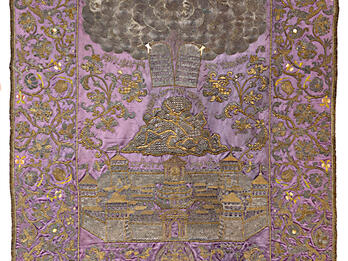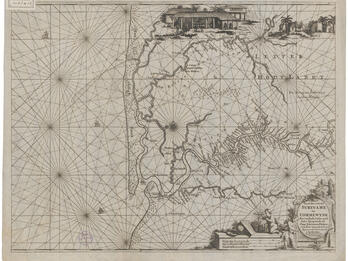Defining Trends of the Early Modern Period
Paradoxically, both centrifugal forces (expulsions, migrations creating global dispersion) and centripetal trends (Hebrew printing, kabbalah) unified Jews in the early modern period.
![M10 622 Manuscript, probably from Ukraine]. Manuscript probably from Ukraine, c. 1740 with a broad collection of practical kabbalah and mystical magic. Facing page manuscript arranged vertically with Hebrew text in the shape of a figure wielding two long objects.](/system/files/styles/text_with_media_mobile_1x/private/images/vol05/Posen5_blackandwhite166_color.jpg?h=cec7b3c9&itok=bXl4WsDD)
The requirements for distinguishing a separate period with respect to the history of the Jews—among them organic unity, unique typical characteristics, and a new historical shift—are indeed found in the early modern period. To highlight the changes that occurred in Jewish society during the early modern period, the Posen Library focuses on two apparently contradictory trends: the centrifugal and the centripetal.
The Centrifugal Trend
On the one hand, centrifugal forces scattered Jews and Jewish communities farther across the globe and cast them into more—and more various—cultural settings than ever before. On the other hand, this geographical mobility—in combination with other, newer factors—served in some ways to unify the Jewish people more thoroughly than ever before. Illustrating these trends and their reciprocal connections will help clarify the uniqueness of the early modern period in Jewish history and also link it to parallel developments in world history.
One would rightly characterize the early modern period as one during which Jews were on the move, as a result of expulsions, fleeing the Inquisition, and pursuing economic and trade opportunities resulting in new communities in port cities and the New World. The migration and itinerance of rabbis and intellectuals was among the phenomena that defined the transmission of Jewish and secular knowledge of this period as well. Alongside Jewish intellectual and scholarly developments, the early modern period is also one of growing heterodoxy.
The Centripetal Trend
While the frequent expulsions and migrations dispersed and divided the Jews of the diaspora, other elements worked to create, if not uniformity, then mutual intelligibility, and even familiarity among the many physically distant Jewish communities and their various traditions and cultures. These unifying elements include the rise of Hebrew printing, which facilitated the wide dispersion and availability of all kinds of Hebrew books and belles lettres in Yiddish, Ladino, Spanish, and other languages. The dispersion of Jewish exiles from Spain hastened the dissemination and study of kabbalah, the system of religious and mystical thought that emerged as a central feature of Spanish Jewish cultures in the twelfth century. Thanks to the printing press, much kabbalistic literature, the Zohar and commentaries, became available during the early modern period.
As one of the places where Jews were free to practice openly, Italy was a main locus of Jewish migration, even as different local rulers established different rules for Jewish residence. Ashkenazim, Jews of Sephardic descent from the Ottoman Empire, and Marranos and New Christians of Sephardic descent arriving from Western Europe and planning to return to their Jewish practice all found themselves living together in distinct communities in Italy.
Whereas those Jews who remained in Western Europe after the Spanish Expulsion continued to speak Iberian languages, Ladino (or Judeo-Spanish) emerged as the language of the Spanish exiles throughout the Ottoman Empire, and Yiddish continued to develop as the language spoken among Ashkenazi Jewry. As a center of Hebrew printing, the presence of all these different Jewish communities contributed to the publication of a rich corpus of books in the nascent Jewish literary languages, Yiddish and Ladino, and also in Spanish and Portuguese.



